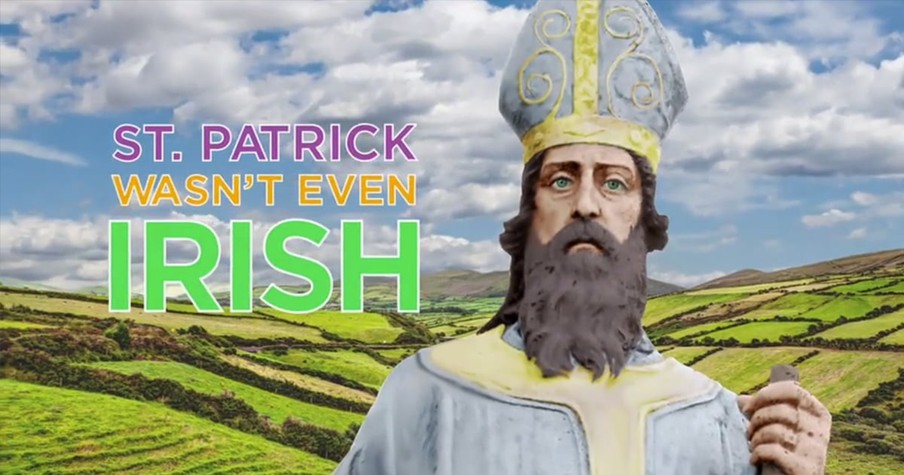
St. Patrick's Day Myths and Facts We Bet You Didn't Know
March 13, 2024

Why do we wear green on March 17? Did St. Patrick really bring Christianity to Ireland? What's the deal with the snakes and shamrocks? Read on to find out these St Patrick's Day myths and learn some really cool facts!
1. St Patrick's Day Myths Debunked - We Should Really Wear Blue
According to The Smithsonian, Saint Patrick would have been pinched a lot on his own namesake day. The earliest paintings of him show him wearing blue, not green. In fact, when George III created a new order of chivalry for the Kingdom of Ireland, the Order of St. Patrick, its official color was a sky blue, known as “St. Patrick’s Blue." The color green only became associated with the big day after it was linked to the Irish independence movement in the late 18th century.
2. St. Patrick was Irish
History.com shares that Patrick was born to a Christian deacon and his wife around 390 in what is now England, Scotland or Wales. It's believed that when he was just 16 years old, he was enslaved for six years by Irish raiders who kidnapped him from his home and took him to Ireland. Patrick later fled to England, and received religious instruction before he fled to Ireland to serve as a missionary.
YOU MAY LIKE: Bizarre Facts About the Presidents that Seem Crazy But Are True
3. St. Patrick banished snakes from the Emerald Isle
According to legend, St. Patrick stood on an Irish hillside and preached a sermon that drove the Emerald Isle's serpents into the sea. While it’s true that Ireland is a snake-free land, it probably has always been that way. Before the water that surrounds the island was there, the island would've been covered in ice--way too cold for the snakes to have slithered across. Many scholars actually think the snake tale is more likely an allegory for St. Patrick’s eradication of pagan ideology.
3. St Patrick's Day Myths - St. Patrick brought Christianity to Ireland
Even though St. Patrick did preach as a missionary in Ireland, he probably wasn't the first to do so. Pope Celestine sent a bishop known as Palladius to Ireland before Patrick was a missionary there. This would mean that some inhabitants of the 'Emerald Isle' would have already converted by the time St. Patrick arrived.
4. New Yorkers Love St. Patrick's Day
The idea of celebratory parades isn't actually an Irish tradition at all. Immigrants in Boston and New York were actually the ones who began that tradition. New Yorkers have celebrated the luck of the Irish with a parade since 1762. New York City’s Saint Patrick’s Day Parade is one of the largest parades in the world. Every year, nearly 250,000 participants march up Fifth Avenue. Spectators lining the sidewalks will see many dancers wearing green, numerous kilts and lots of bagpipes, but there's one thing they won't see--automobiles of any kind. The parade doesn’t allow floats or vehicles. While NYC boasts the biggest parade, Hot Springs, Arkansas holds another title--the shortest parade. Its festive parade runs for a mere 98 feet.

RELATED: 30+ Easter Traditions by State (How Does Your State Celebrate?)
5. The Real Reason for The Shamrocks
So just how did the three-leaf clover, or shamrock, become associated with St. Patrick's Day? According to Irish legend, Patrick used the plant when he was first introducing Christianity to Ireland -- as a metaphor for the Holy Trinity.
6. St Patrick's Day Facts - St. Patrick's Day Used to Be 'Dry'
Saint Patrick’s Day was considered a religious holiday in Ireland for most of the 20th Century, which meant that their pubs were closed for business on March 17. The day was converted to a national holiday in 1970, and bars began selling beer on St Patrick's Day.

7. Corned beef is a classic St. Patrick’s Day dish
In the United States corned beef and cabbage are served up on March 17 for St. Patrick's Day, but not in Ireland. Folks on the Emerald Isle enjoy a type of bacon that's similar to ham. Irish immigrants in New York City’s Lower East Side are believed to have substituted corned beef, in the 19th Century. They had bought the less expensive protein from their Jewish neighbors in order to save money.
WATCH: St Patrick's Day Myths and Facts We Bet You Didn't Know
LISTEN: The Touching Story Behind the Promise Gary Sinse Made to a Veteran's Widow That Changed Everything
Featured Image Credit: Youtube/Isabel Ferreira

Today's Devotional
A Prayer for an Open Heart This Holiday Season - Your Daily Prayer - November 25
With so many traditions, travel, meals, and memories to be made, it can be easy to feel anxious and overwhelmed by what is ahead. However, God teaches us in Philippians not to worry about anything but to pray and share our petitions with Him with gratitude.
Today's Devotional
A Prayer for an Open Heart This Holiday Season - Your Daily Prayer - November 25
With so many traditions, travel, meals, and memories to be made, it can be easy to feel anxious and overwhelmed by what is ahead. However, God teaches us in Philippians not to worry about anything but to pray and share our petitions with Him with gratitude.
Past Stories
- School in Arkansas Mourns the Loss of Their Beloved Emotional Support Dog Abby
- 93-Year-Old Has Made Sure To Attend Every High School Football Game Since 1946
- Texas Mom Doesn't Remember Delivering Triplets After Rare Complication After Birth
- United Airlines Pilot Buys Pizza For 155 Passengers After They Make An Unexpected Stop
- Teenager With Down Syndrome Enjoys Playing Kickball After Parents Organize Neighborhood Game
- Woman in Shock After Finding Winning Lottery Ticket At the Bottom of Her Purse
- Australian Couple Walks Into Their Bedroom To Find the Cutest Koala
- 5 Boys and Their Father Were Saved By Good Samaritan After Explosion
- Daughter of WWII Soldier Finally Learns What Happened To Him, 80 Years Later
- Sisters Scream With Joy Watching Their 4-Year-Old Sister Take Her First Steps
- Her Mom Put a Message in a Bottle As a Child, 26 Years Later Her Classmate Found It
- This Missouri School Was Renamed After Their Much Loved and Dedicated Custodian
- Michael Strahan's Daughter is Now Cancer Free and Has Taught Him All About Perseverance
- These Two Newlyweds Found Love in Their Late 90s, After Meeting At Their Retirement Home
- Sisters Who Were Adopted By Separate Families Nearly 40 Years Ago Reunite After DNA Tests
- Oldest Living Person in the US Passes Away at 115, After a Long and Faithful Life
- At Just 20 and 22 Years Old, These Two Sisters From Minnesota Saved Their Family Farm
- After Over 450 Days in a Shelter, Boone and Rellie Find Their Forever Home, Together
- Sweet Kitten Named Coraline Loses Both Her Eyes, but Inspires Many with Her Spirit
- Donny Osmond Sees the 'End of the Tunnel' Coming After Performing for Over 6 Decades
- An Iguana Hitches a Ride on a Garbage Truck in Tennessee, Now Trying to Find Its Owner
- 6-Year-Old Starts 'Poop Scooping' Business to Help Animals and Adopt One of His Own
- Bride's Dad Drops During Father-Daughter Dance, but Things Lined up Perfectly to Save His Life
- Young North Carolina Father Risked His Life To Save a Couple and Dog From a Sinking Truck
- UPS Driver Jumps into Action As He Spots Elderly Woman on the Ground & Says It Was All God
- Rescuer Braces for the Worst After Spotting Kitten on the Side of the Road, Then Sees a Paw Move
- AJ Griffin Gives Up High-Paying Career with NBA to Follow God
- These Former Conjoined Twins Finally Go Home After Their First Birthday
- Teenager From Iowa Uses His Flying Skills to Help Hurricane Helene Victims
- Son Saves For 9 Months and Surprises Mom By Paying Off Her Mortgage
- Woman's Home is Surrounded By 100 Raccoons, and They Aren't Leaving Anytime Soon
- Dog Saves Her Owner's Life By Sitting in the Middle of the Road
- Widower Shares the Last Thing His Wife Told Their Son Before She Passed Away From Cancer
- A Nurse Saved Her Life 35 Years Ago, Now, She is Surprising Her With a Visit
- These Twin Sisters Have An Important Message To Share On Their 102nd Birthday
- This Brave 5-Year-Old Saved Her Mother's Life By Calling 911
- 79-Year-Old Broke Her Ankle After Scattering Her Mom's Ashes, Then Strangers Save the Day
- Dad Travels Through Mud and Debris to Walk His Daughter Down the Aisle
- Owner's Trip to the Vet with Unwell Dog Results in the Craziest X-Ray
- After Getting Lost in Yellowstone, This Precious Cat Made His Way Back Home To California
- Mom's Funny Response To Daughter's Dirty Sock On The Floor Goes Viral & Ends Up Doing Good
- A Kidnapped Boy Is Found After 70 Years and Reunited With His Family
- This Puppy Was Found With a Note That Read 'Help Me,' Now He's Looking For a New Home
- Excited Mom Couldn't Wait to See Son's Back to School Pictures, but Funny Results Make Her LOL
- When This Police Officer Pulled Her Over, He Changed Her Life Forever
- She Just Met Her Vietnam Veteran Father After 50 Years, Now He is Walking Her Down the Aisle
- Fearless Father Waits on Porch to Catch the Stranger Peeking in His Daughter's Window
- This 5th Grade Teacher Eats Lunch In the Cafeteria Every Day
- Amy Grant Has a New Perspective After Losing Her 'Superpower' in Bike Accident
- 'God Did It' Says 18-Year-Old After Waking Up From a Coma Following a Crash
Top Music Videos

CCM Magazine Matthew West | '18 Summers' (acoustic)

The Statler Brothers 'Til the Storm Passes By' The Statler Brothers Live Performance

Colton Dixon 'The Other Side' - Colton Dixon Song For Lost Loved Ones

Crowder Crowder's Powerful 'Somebody Prayed' Lyric Video

Tauren Wells Tauren Wells - Making Room
Blogs
At GodTube, you’ll find daily inspirational videos to lift your spirits and encourage you in your walk with God. Popular videos include worship music from your favorite Christian artists, cute videos with adorable kids and animals, hilarious videos from Christian comedians, user-uploaded videos, and clean viral videos to brighten your day.









